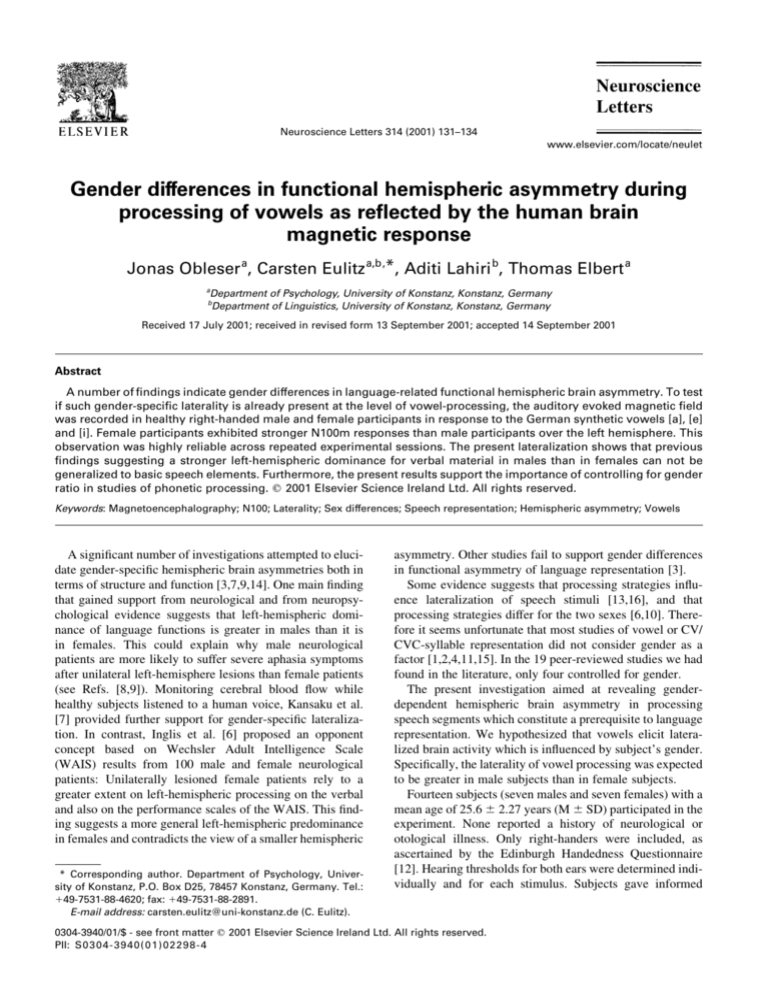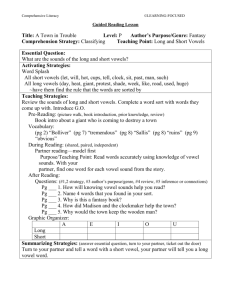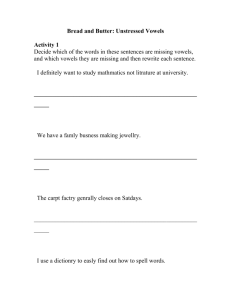
Neuroscience Letters 314 (2001) 131–134
www.elsevier.com/locate/neulet
Gender differences in functional hemispheric asymmetry during
processing of vowels as reflected by the human brain
magnetic response
Jonas Obleser a, Carsten Eulitz a,b,*, Aditi Lahiri b, Thomas Elbert a
a
Department of Psychology, University of Konstanz, Konstanz, Germany
Department of Linguistics, University of Konstanz, Konstanz, Germany
b
Received 17 July 2001; received in revised form 13 September 2001; accepted 14 September 2001
Abstract
A number of findings indicate gender differences in language-related functional hemispheric brain asymmetry. To test
if such gender-specific laterality is already present at the level of vowel-processing, the auditory evoked magnetic field
was recorded in healthy right-handed male and female participants in response to the German synthetic vowels [a], [e]
and [i]. Female participants exhibited stronger N100m responses than male participants over the left hemisphere. This
observation was highly reliable across repeated experimental sessions. The present lateralization shows that previous
findings suggesting a stronger left-hemispheric dominance for verbal material in males than in females can not be
generalized to basic speech elements. Furthermore, the present results support the importance of controlling for gender
ratio in studies of phonetic processing. q 2001 Elsevier Science Ireland Ltd. All rights reserved.
Keywords: Magnetoencephalography; N100; Laterality; Sex differences; Speech representation; Hemispheric asymmetry; Vowels
A significant number of investigations attempted to elucidate gender-specific hemispheric brain asymmetries both in
terms of structure and function [3,7,9,14]. One main finding
that gained support from neurological and from neuropsychological evidence suggests that left-hemispheric dominance of language functions is greater in males than it is
in females. This could explain why male neurological
patients are more likely to suffer severe aphasia symptoms
after unilateral left-hemisphere lesions than female patients
(see Refs. [8,9]). Monitoring cerebral blood flow while
healthy subjects listened to a human voice, Kansaku et al.
[7] provided further support for gender-specific lateralization. In contrast, Inglis et al. [6] proposed an opponent
concept based on Wechsler Adult Intelligence Scale
(WAIS) results from 100 male and female neurological
patients: Unilaterally lesioned female patients rely to a
greater extent on left-hemispheric processing on the verbal
and also on the performance scales of the WAIS. This finding suggests a more general left-hemispheric predominance
in females and contradicts the view of a smaller hemispheric
* Corresponding author. Department of Psychology, University of Konstanz, P.O. Box D25, 78457 Konstanz, Germany. Tel.:
149-7531-88-4620; fax: 149-7531-88-2891.
E-mail address: carsten.eulitz@uni-konstanz.de (C. Eulitz).
asymmetry. Other studies fail to support gender differences
in functional asymmetry of language representation [3].
Some evidence suggests that processing strategies influence lateralization of speech stimuli [13,16], and that
processing strategies differ for the two sexes [6,10]. Therefore it seems unfortunate that most studies of vowel or CV/
CVC-syllable representation did not consider gender as a
factor [1,2,4,11,15]. In the 19 peer-reviewed studies we had
found in the literature, only four controlled for gender.
The present investigation aimed at revealing genderdependent hemispheric brain asymmetry in processing
speech segments which constitute a prerequisite to language
representation. We hypothesized that vowels elicit lateralized brain activity which is influenced by subject’s gender.
Specifically, the laterality of vowel processing was expected
to be greater in male subjects than in female subjects.
Fourteen subjects (seven males and seven females) with a
mean age of 25.6 ^ 2.27 years (M ^ SD) participated in the
experiment. None reported a history of neurological or
otological illness. Only right-handers were included, as
ascertained by the Edinburgh Handedness Questionnaire
[12]. Hearing thresholds for both ears were determined individually and for each stimulus. Subjects gave informed
0304-3940/01/$ - see front matter q 2001 Elsevier Science Ireland Ltd. All rights reserved.
PII: S03 04 - 394 0( 0 1) 02 29 8- 4
J. Obleser et al. / Neuroscience Letters 314 (2001) 131–134
132
Table 1
Formant frequencies of the vowels a
[a]
[e]
[i]
[ ]
F1 (Hz)
F2 (Hz)
F3 (Hz)
780
370
250
350
1250
2250
2700
1400
2600
2800
3400
2500
a
Frequencies of the first three formants of all vowels are
shown. Details of fixed F0, F4–F6 frequencies are given in the text.
consent and were paid the equivalent of $25 for their participation.
In a target detection task, subjects listened to pseudorandom sequences of four synthetic German vowels.
These were Klatt-synthesized realizations of the vowels
[a] (as in ‘father’), [e] (similar to ‘bait’ but not diphthongized), [i] (as in ‘beat’) and as a target a schwa-like vowel
[ ]. Every subject easily identified the three non-target
stimuli as the respective German vowels.
All stimuli had a duration of 600 ms and a fundamental
frequency F0 of 129 Hz that fell linearly to 119 Hz. Stimuli
differed in formant frequencies F1–F3, as depicted in Table
1. F4 (3900 Hz), F5 (4700 Hz) and F6 (5100 Hz) were held
constant across stimuli, as were on- and off-set ramps (50
ms Gaussian onset, 150 ms Gaussian offset).
The vowel sequences were presented binaurally at 50 dB
SPL above respective hearing threshold via a non-magnetic
and echo-free stimulus delivery system. Each sequence
consisted of 520 stimuli with a randomized inter-stimulusinterval of 2000 ^ 200 ms and a target probability of 7%.
Subjects pressed a button with their right index finger when
detecting the target vowel to ensure that an active processing mode was maintained. Subjects watched silent videos
to maintain a state of alertness and to avoid excessive eye
movements. For the measurement a supine position was
chosen, ensuring that the subject did not move.
In every subject the experiment was repeated after 1 week
to assess re-test reliability and to separate source localization errors elicited through biological or environmental
noise from systematic intraindividual differences.
Auditory magnetic fields (AEF) were recorded using a
whole head neuromagnetometer (MAGNES 2500, 4D
Neuroimaging) operated within a magnetically shielded
room (Vacuumschmelze). Epochs of 1200ms (including a
200 ms pre-trigger baseline) were recorded with a bandwidth from 0.1 to 200 Hz and a 678.17 Hz sampling rate.
Epochs containing button presses or excessive muscle or
eye activity (indicated by peak-to-peak amplitude .3.5
pT or co-registered EOG-signal .100 mV in one of the
channels) were rejected. Artifact-free epochs (250–480)
remaining for every non-target vowel were averaged after
off-line noise correction. A 20 Hz lowpass filter (zero phaseshift butterworth, 12 dB/oct) was subsequently applied to
the average.
Further analysis was confined to the N100m component
of the brain response waveform. N100m was defined as the
prominent deflection in the time range between 90 and 150
ms. Additionally, isofield contour plots of the magnetic field
distribution were inspected visually. N100m peak amplitude
was calculated as the maximum root mean square (RMS)
over 34 magnetometer channels selected to include the field
extrema over the left and the right hemisphere, respectively.
Peak latency was defined as the sampling point by which the
RMS reached its maximum. The same channel selections
were used for magnetic source imaging: An equivalent
current dipole (ECD) in a spherical volume conductor was
modeled at every sampling point separately for the left and
the right hemisphere.
N100m source parameters were determined as the median
of 16 ^ 5 ECD solutions in the latency range of 30 ms
before the RMS peak. To be included in median calculation,
single ECD goodness of fit was required to be at least 0.90
and ECD location had to amount to at least 1.5 cm in
medial-lateral direction and 3–8 cm in inferior-superior
direction.
RMS N100m peak latency and amplitude and the ECD
source strength were then submitted to an ANOVA with the
repeated measures factors vowel type ([a], [e], [i]), hemisphere (left, right), session (first, second) and the between
factor gender (female, male). Scheffé tests were used for
post-hoc comparisons, P-values were adjusted using the
Greenhouse–Geisser correction.
Two subjects were excluded from data analysis due to a
very poor signal to noise ratio of the N100m. Fig. 1 depicts
the grand average RMS of the vowel-elicited waveforms
over the left and the right hemisphere averaged separately
for gender. N100m peak latency was shorter for [a] than for
the other vowels (main effect vowel type Fð2; 20Þ ¼ 13:91,
Fig. 1. Root mean squared amplitudes (RMS) over 34 channels
over the left (left column) and the right (right column) hemisphere grand averaged across all female and male subjects are
shown. Different line styles indicate the RMS waveforms for
female and male subjects. Upper and lower row represent the
results for the vowels [a] and [i], respectively.
J. Obleser et al. / Neuroscience Letters 314 (2001) 131–134
e ¼ 0.81, P , 0:001) but was not influenced by gender or
hemisphere. Neither N100m amplitude nor ECD source
strength revealed main effects of hemisphere or gender.
This also held true for analysis of ECD locations that will
be reported elsewhere. Irrespectively of the particular
vowel, hemispheric asymmetry of the amplitude was different for male and female subjects.
Fig. 2 shows the source strength of the N100m for both
sexes and hemispheres. A mean goodness of fit of
0.97 ^ 0.01 confirmed the adequacy of the source model.
The difference described for the N100m RMS-amplitude
was corroborated by the source strength: An ANOVA calculated for the median dipole moment |Q| yielded a gender £
hemisphere interaction, i.e. the modulation of source
strength across hemispheres was different and in this case
opposite for the two hemispheres (Fð1; 10Þ ¼ 5:96,
P , 0:05). Post-hoc testing revealed that dipole sources in
the left hemisphere were significantly stronger in female
than in male participants (P , 0:05). To further investigate
the hemispheric asymmetry of the strength of the evoked
sources in auditory cortex, the laterality score for the dipole
moment |Q| was calculated as (|Q|left 2 |Q|right) / (|Q|left 1
|Q|right). The mean laterality score for male subjects was
20.21, indicating right-hemispheric preponderance, while
female subjects scored on average 10.16, indicating a stronger left- than right-hemispheric activity. A consecutive
ANOVA with the repeated measures factors session and
vowel type and the between factor gender produced a
main effect of gender (Fð1; 10Þ ¼ 6:55, P ¼ 0:028). This
hemispheric gender difference appeared for all three
vowel stimuli and across both experimental sessions. The
corresponding re-test reliability is illustrated in Fig. 3.
Individual laterality scores (pooled across vowels) in the
first session are plotted against the scores in the second
session. The strong and highly significant correlation
(rSpearman ¼ 0.93, P , 0:0001) indicates that the type of
hemispheric laterality reappears consistently, even on
different days of testing.
Fig. 2. Mean source strength (^SEM) of the equivalent current
dipole (ECD) is shown separately for both hemispheres and
subject’s gender. Significant post-hoc tests are indicated by an
asterisk.
133
Fig. 3. Individual laterality coefficients (pooled across vowels) of
the first experimental session are plotted against those of the
second experimental session. Male subjects are represented
by crosses, female subjects by circles. Note the high re-test reliability of the lateralization pattern.
The main rationale of this analysis was to reveal the
influence of gender on lateralized vowel processing. As
outlined above, most of previous studies did not control
for gender ratio. The present data suggest gender differences
in the lateralized processing of vowels. However the pattern
of asymmetry we observed cannot readily be derived from
reports of greater left-lateralized language processing in
male subjects [7–9]. Despite a rather small sample size a
clear statistical outcome demonstrated a highly reliable
pattern of gender-specific lateralization whereby female
participants produced larger activity in the left hemisphere
than male participants (Figs. 1–3). This relationship
between subject’s gender and hemisphere was confirmed
when comparing the strength of ECD sources evoked in
auditory cortex. In the measured signal amplitude, error
variance is introduced through interindividual differences
in exact sensor-to-head position which may obscure experimental effects.
To our knowledge, this type of gender-specific lateralization of speech processing has not been reported previously.
A recent MEG study (personal communication with M.
Haerle and B. Rockstroh) demonstrated a similar lateralization pattern in male and female subjects in a language
production task. The left ear advantage in male participants
observed by Meinschaefer et al. [10] points in the same
direction – although they examined processing of syllable
structure, a task that was expected to trigger right-hemispheric dominant activity.
It is possible that the stronger right-hemispheric activity
in men results from a more sound-based processing [5]
whereas the reversed pattern in female listeners [6] can be
explained if we assume that females may prefer verbal strategies. In this context, it is noteworthy that this particular set
of vowels can be categorized and subdivided on a phonological level (thereby assuming that vowel discrimination is
based on the extraction of phonological features) as well as
on a non-linguistic acoustic level, i.e. by merely extracting
spectral envelope information. A discrimination strategy
relying on one or the other mechanism would lead to the
134
J. Obleser et al. / Neuroscience Letters 314 (2001) 131–134
same behavioral response in the present study but would
produce different degrees of brain hemispheric asymmetry.
The classic view of greater left-lateralized language
processing in males [8,9] is mainly based on clinical observations and lesion studies. The common interpretation of
these studies links damaged brain structures to functional
deficits in a deterministic mono-causal fashion. However a
considerable body of evidence shows that structural damage
in one hemisphere also affects functioning in the other unlesioned hemisphere (see Ref. [11] for a review). Consequently, the results of the lesion studies might be
confounded by changes in the functioning of the unlesioned
hemisphere.
In summary, the results show that hemispheric language
asymmetry as reflected by processing of vowels is influenced by subject’s gender: female but not male subjects
exhibited stronger left-than right hemisphere activity. The
results also revealed a surprisingly high re-test reliability
across experimental sessions. Vowel processing constitutes
a prerequisite for further decoding and processing speech
content, and language-related brain asymmetry is consequently influenced. The present findings underline the
importance of considering gender as a variable even when
exploring basic levels of speech processing.
Research was supported by the Deutsche Forschungsgemeinschaft and the Volkswagen-Stiftung. The authors wish
to thank Michaela Schlichtling, Ursula Lommen and
Isabella Paul for their help during the data acquisition,
Eugen Diesch for supplying the stimulus material and
Nathaniel Pihama for correcting the manuscript.
[1] Bellis, T.J., Nicol, T. and Kraus, N., Aging affects hemispheric asymmetry in the neural representation of speech
sounds, J. Neurosci., 20 (2000) 791–797.
[2] Eulitz, C., Diesch, E., Pantev, C., Hampson, S. and Elbert, T.,
Magnetic and electric brain activity evoked by the processing of tone and vowel stimuli, J. Neurosci., 15 (1995) 2748–
2755.
[3] Frost, J.A., Binder, J.R., Springer, J.A., Hammeke, T.A., Bellgowan, P.S.F., Rao, S.M. and Cox, R.W., Language processing is strongly left lateralized in both sexes: evidence from
functional MRI, Brain, 122 (1999) 199–208.
[4] Gootjes, L., Raij, T., Salmelin, R. and Hari, R., Left-hemisphere dominance for processing of vowels: a wholescalp neuromagnetic study, NeuroReport, 10 (1999) 2987–
2991.
[5] Hickock, G. and Poeppel, D., Towards a functional neuroanatomy of speech perception, Trends Cogn. Sci., 4 (2000)
131–138.
[6] Inglis, J., Ruckman, M., Lawson, J.S., MacLean, A.W. and
Monga, T.N., Sex differences in the cognitive effects of
unilateral brain damage, Cortex, 18 (1982) 257–276.
[7] Kansaku, K., Yamaura, A. and Kitazawa, S., Sex differences
in lateralization revealed in the posterior language areas,
Cereb. Cortex, 10 (2000) 866–872.
[8] Kimura, D., Sex and Cognition, MIT press, Cambridge,
1999, pp. 91–103.
[9] McGlone, J., Sex differences in human brain asymmetry: a
critical survey, Behav. Brain. Sci., 3 (1980) 215–263.
[10] Meinschaefer, J., Hausmann, M. and Güntürkün, O., Laterality effects in the processing of syllable structure, Brain
Lang., 70 (1999) 287–293.
[11] Nudo, R.J., Recovery after damage to motor cortical areas,
Curr. Opin. Neurobiol., 9 (1999) 740–747.
[12] Oldfield, R., The assessment and analysis of handedness:
the Edinburgh Questionnaire, Neuropsychologia, 9 (1971)
97–113.
[13] Poeppel, D., Yellin, E., Phillips, C., Roberts, T.P.L., Rowley,
H.A., Wexler, K. and Marantz, A., Task-induced asymmetry
of the auditory evoked M100 neuromagnetic field elicited
by speech sounds, Cogn. Brain. Res., 4 (1996) 231–242.
[14] Shaywitz, B.A., Shaywitz, S.E., Pugh, K.R., Constable, R.T.,
Skudlarski, P., Fulbright, R.K., Bronen, R.A., Fletcher, J.M.,
Shankweiler, D.P., Katz, L. and Gore, J.C., Sex differences in
the functional organization of the brain for language,
Nature, 373 (1995) 607–609.
[15] Szymanski, M.D., Rowley, H.A. and Roberts, T.P.L., A hemispherically asymmetrical MEG response to vowels,
NeuroReport, 10 (1999) 2481–2486.
[16] Zatorre, R.J., Evans, A.C., Meyer, E. and Gjedde, A., Lateralization of phonetic and pitch discrimination in speech
processing, Science, 256 (1992) 846–849.









